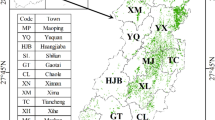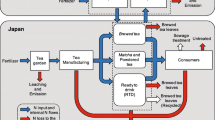Abstract
Tea plantations are rapidly expanding in China and other countries in the tropical and subtropical zones, driven by relatively high private economic benefit. However, the impact of tea plantations on the regional environment, including ecosystem services and disservices are unclear. In this study, we developed an assessment framework for determining the private economic benefits and environmental externalities (the algebraic sum of the regulating services and disservices) of tea plantations in China. Our results showed that tea plantations provided private economic benefits of 5,652 yuan ha−1 year−1 (7.6 yuan = 1 USD in 2007) for tea farmers, plus positive environmental externalities of 6,054 yuan ha−1 year−1 for the society. The environmental externalities were calculated as the sum of the value of four regulating services, including carbon sequestration (392 yuan ha−1 year−1); soil retention (72 yuan ha−1 year−1); soil fertility protection (3,189 yuan ha−1 year−1) and water conservation (2,685 yuan ha−1 year−1), and three disservices, including CO2 emission (−39 yuan ha−1 year−1), N2O emission (−137 yuan ha−1 year−1) and nonpoint source pollution (−108 yuan ha−1 year−1). Before the private optimal level, the positive environmental externalities can be maintained by private economic benefits; if a social optimal level is required, subsidies from government are necessary.





Similar content being viewed by others
References
Akiyama, H., Yan, X. Y., & Yag, K. (2006). Estimations of emission factors for fertilizer-induced direct N2O emissions from agricultural soils in Japan: Summary of available data. Soil Science and Plant Nutrition, 52(6), 774–787.
Antóna, M. A., Muñoza, P., Castells, F., Monteroa, J. I., & Soliva, M. (2005). Improving waste management in protected horticulture. Agronomy for Sustainable Development, 25(4), 447–453.
Cai, Y. B., Zhang, H., Pan, W. B., Chen, Y. H., & Wang, X. R. (2012). Land use pattern, socio-economic development, and assessment of their impacts on ecosystem service value: Study on natural wetlands distribution area (NWDA) in Fuzhou city, southeastern China. Environmental Monitoring and Assessment. doi:10.1007/s10661-012-2929-x.
Chang, J., Wu, X., Liu, A., Wang, Y., Xu, B., Yang, W., Meyerson, L., Gu, B. J., Peng, C., & Ge, Y. (2011). Assessment of net ecosystem services of plastic greenhouse vegetable cultivation in China. Ecological Economics, 70(4), 740–748.
Chapin, F. S., III, & Mooney, P. A. (2002). Principles of terrestrial ecosystem ecology. New York: Springer.
Chen, Z. M. (2000). Chinese tea dictionary, 12 (pp. 127). Beijing: China Light Industry Press (in Chinese).
Chen, L., ShangGuan, L., Wu, Y., Xu, L., & Fu, F. (2012). Study on the residue and degradation of fluorine-containing pesticides in Oolong tea by using gas chromatography–mass spectrometry. Food Control, 25(2), 433–440.
Ciais, P., Bousquet, P., Freibauer, A., & Naegler, T. (2007). Horizontal displacement of carbon associated with agriculture and its impacts on atmospheric CO2. Global Biogeochemical Cycles, 21, 40–51.
Costanza, R., d’Arge, R., de Groot, R., Farber, S., Grasso, M., Hannon, B., Limburg, K., Naeem, S., O’Neill, R. V., & Paruelo, J. (1997). The value of the world's ecosystem services and natural capital. Nature, 387, 253–260.
Duan, S. S., Zhang, J. E., Cai, K. J., & Cu, N. (2001). Effect of the soil and water conservation of forest and tea bush utilizing patterns on crimson soil slopeland in Heshan, Guangdong. Tropical Geography, 21(2), 99–103 (in Chinese).
FAO (2008). FAOSTAT data. http://www.fao.org. Accessed 23 May, 2011.
Firbank, L., Bradbury, R.B., McCracken, D.I., Stoate C. (2013). Delivering multiple ecosystem service from enclosed farmland in the UK. Agriculture, Ecosystem and Environment, 166, 65–75.
Foley, J. A., DeFries, R., Asber, G. P., Barford, C., Bonan, G., Carpenter, S. A., Chapin, F. S., Coe, M. T., Daily, G. C., Gibbs, H. K., Helkowski, J. H., Holloway, T., Howard, E. A., Kucharik, C. J., Monfreda, C., Patz, J. A., Prentice, I. C., Ramankutty, A., & Snyder, P. K. (2005). Global consequences of land use. Science, 309, 570–574.
Fu, X.Q., Li, Y., Xiao, R.L., Tong, C.L., Wu, J.S. (2010). N2O emissions from a tea field in subtropical China. Soil Solutions for a Changing World. The 19th World Congress of Soil Science.
Fung, K. F., Carr, H. P., Zhang, J., & Wong, M. H. (2008). Growth and nutrient uptake of tea under different aluminum concentration. Journal of the Science of Food and Agriculture, 88(9), 1582–1591.
Glover, J. D., Reganold, J. P., Bell, L. W., Borevitz, J., Brummer, E. C., Buckler, E. S., Cox, C. M., Cox, T. S., Crews, T. E., Culman, S. W., DeHaan, L. R., Eriksson, D., Gill, B. S., Holland, J., Hu, F., Hulke, B. S., Ibrahim, A. M. H., Jackson, W., Jones, S. S., Murray, S. C., Paterson, A. H., Ploschuk, E., Sacks, E. J., Snapp, S., Tao, D., Van Tassel, D. L., Wade, L. J., Wyse, D. L., & Xu, Y. (2010). Increased food and ecosystem security via perennial grains. Science, 328, 1638–1639.
Han, W. Y., & Li, Q. (2002). The current situation of fertilizer application in tea plantations and the high efficiency fertilizer application technique of environmental friendly tea plantations. China Tea, 24(6), 29–31 (in Chinese).
Hu, H. B., Liu, W. J., & Cao, M. (2008). Impact of land use and land cover changes on ecosystem services in Menglun, Xishuangbanna, Southwest China. Environmental Monitoring and Assessment, 146, 147–156.
Ju, X. T., Xing, G. X., Chen, X. P., Zhang, S. L., Zhang, L. J., Liu, X. J., Cui, Z. L., Yin, B., Christie, P., Zhu, Z. L., & Zhang, F. S. (2009). Reducing environmental risk by improving N management in intensive Chinese agricultural systems. Proceedings of the National Academy of Sciences of the United States of America, 106(9), 3041–3046.
Kamau, D. M., Spiertz, J. H. J., Oenema, O., & Owuor, P. O. (2008). Productivity and nitrogen use of tea plantations in relation to age and genotype. Field Crops Research, 108(1), 60–70.
Kaye, J. P., Groffman, P. M., Grimm, N. B., Baker, L. A., & Pouyat, R. V. (2006). A distinct urban biogeochemistry? Trends in Ecology & Evolution, 21(4), 192–199.
Kremen, C. (2005). Managing ecosystem services: What do we need to know about their ecology? Ecology Letters, 8(5), 468–479.
Lai, L., Huang, X.J. (2008). Environmental cost accounting of chemical fertilizer utilization in China. Bioinformatics and Biomedical Engineering. The 2nd International Conference.
Li, S. Y., Wu, X., Xue, H., Gu, B. J., Cheng, H., Zeng, J. M., Peng, C. H., Ge, Y., & Chang, J. (2011). Quantifying carbon storage for tea plantations in China. Agriculture, Ecosystems and Environment, 141(3–4), 390–398.
Lu, F., Wang, X. K., Han, B., Ouyang, Z. Y., Duan, X. N., Zheng, H., & Miao, H. (2009). Soil carbon sequestrations by nitrogen fertilizer application, straw return and no-tillage in China's cropland. Global Change Biology, 15(2), 281–305.
Lv, Y., Gu, S. Z., & Guo, D. M. (2010). Valuing environmental externalities from rice-wheat farming in the lower reaches of the Yangtze River. Ecological Economics, 69(7), 1436–1442.
MAC. (2005). Agricultural year book of China. Beijing: Agriculture Press (in Chinese).
Madhu, M., Sahoo, D. C., Sharda, V. N., & Sikka, A. K. (2011). Rainwater-use efficiency of tea (Camellia sinensis (L.)) under different conservation measures in the high hills of south India. Applied Geography, 31(2), 450–455.
Millennium Ecosystem Assessment (MA). (2003). Ecosystems and human well-being: Current states and trends assessment: Cultivated Systems. Washington: Island Press.
Millennium Ecosystem Assessment (MA). (2005). Synthesis. Washington: Island Press.
NBSC (National Bureau of Statistics of China). (2008). China Statistical Year Book, 2008. Beijing: China Statistics Press.
NBSC (National Bureau of Statistics of China). (2011). China Statistical Year Book, 2011. Beijing: China Statistics Press.
Olschewski, R., Tscharntke, T., Benitez, P. C., Schwarze, S., Klein, A. M. (2006). Economic evaluation of pollination services comparing coffee landscapes in Ecuador and Indonesia. Ecology and Society, 11, 7 (online). http://www.ecologyandsociety.org/vol11/iss1/art7/.
Paquette, A., & Messier, C. (2010). The role of plantations in managing the world’s forests in the Anthropocene. Frontiers in Ecology and the Environment, 8(1), 27–34.
Piao, S., Fang, J. Y., Ciais, P., Peylin, P., Huang, Y., Stich, S., & Wang, T. (2009). The carbon balance of terrestrial ecosystems in China. Nature, 458, 1009–1013.
Sandhu, H. S., Wratten, S. D., Cullen, R., & Case, B. (2008). The future of farming: the value of ecosystem services in conventional and organic arable land: An experimental approach. Ecological Economics, 64, 835–848.
Schlesinger, W. H. (2010). On fertilizer-induced soil carbon sequestration in China's croplands. Global Change Biology, 16(2), 849–850.
SDPCCPD (State Development Planning Commission of China Price Department). (2008). China agricultural cost and benefit data compilation. Beijing: China Statistics Press (in Chinese).
Steffan-Dewenter, I., Kessler, M., Barkmann, J., Bos, M. M., Buchori, D., et al. (2007). Tradeoffs between income, biodiversity, and ecosystem functioning during tropical rainforest conversion and agroforestry intensification. Proceedings of the National Academy of Sciences of the United States of America, 104(12), 4973–4978.
Swinton, S. M., Lupi, F., Robertson, G. P., & Hamilton, S. K. (2007). Ecosystem services and agriculture: Cultivating agricultural ecosystems for diverse benefits. Ecological Economics, 64(2), 245–252.
Tokuda, S., & Hayatsu, M. (2000). Nitrous oxide production from strongly acid tea field soils. Soil Science and Plant Nutrition, 46(4), 835–844.
Wang, H., Xu, R. K., Wang, N., & Li, X. H. (2010). Soil acidification of alfisols as influenced by tea cultivation in eastern China. Pedosphere, 20(6), 799–806.
Wang, S. J., Liu, J., Wang, R. Q., Ni, Z. R., Xu, S. P., & Sun, Y. Y. (2012). Impact of socioeconomic development on ecosystem services and its conservation strategies: A case study of Shandong Province, China. Environmental Monitoring and Assessment, 184, 3213–3229.
Xie, Z. B., Zhu, J. G., Liu, G., Cadisch, G., Hasegawa, T., Chen, C. M., Sun, H. F., Tang, H. Y., & Zeng, Q. (2007). Soil organic carbon stocks in China and changes from 1980s to 2000s. Global Change Biology, 13(9), 1989–2007.
Xiong, L. F., Zhao, Y. Z., Gong, J., Long, J. Q., Liu, Y. Q., Zhang, D. B., & Fu, H. (2007). Influence of the cultivation-free tea gardens of sloping fields on water and soil conservation and soil properties. Tea Communication, 34, 10–14 (In Chinese).
Xue, D., Gao, Y., Yao, H., & Huang, C. (2009). Nitrification potentials of Chinese tea orchard soils and their adjacent wasteland and forest soils. Journal of Environmental Sciences, 21(9), 1225–1229.
Zang, S. Y., Wu, C. S., Liu, H., & Na, X. D. (2011). Impact of urbanization on natural ecosystem service values: A comparative study. Environmental Monitoring and Assessment, 179, 575–588.
Zheng, H., Chen, F., Ouyang, Z., Tu, N. M., Xu, W., Wang, X., Miao, H., Li, X., & Tian, Y. (2008). Impacts of reforestation approaches on runoff control in the hilly red soil region of Southern China. Journal of Hydrology, 356(1–2), 174–184.
Acknowledgments
We are grateful for the funding provided by the National Science Foundation of China (no. 31170305 and no. 30970281).
Author information
Authors and Affiliations
Corresponding author
Electronic supplementary material
Below is the link to the electronic supplementary material.
ESM 1
(PDF 488 kb)
Rights and permissions
About this article
Cite this article
Xue, H., Ren, X., Li, S. et al. Assessment of private economic benefits and positive environmental externalities of tea plantation in China. Environ Monit Assess 185, 8501–8516 (2013). https://doi.org/10.1007/s10661-013-3191-6
Received:
Accepted:
Published:
Issue Date:
DOI: https://doi.org/10.1007/s10661-013-3191-6




